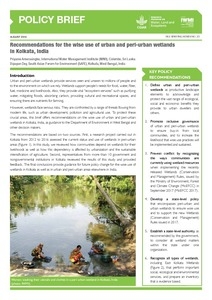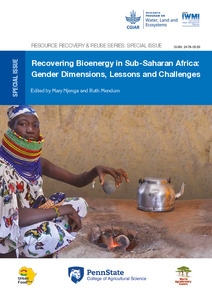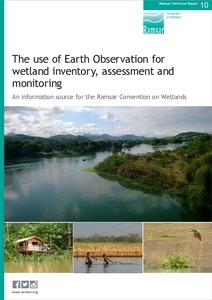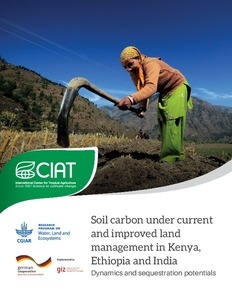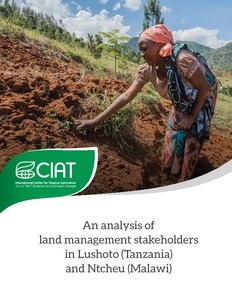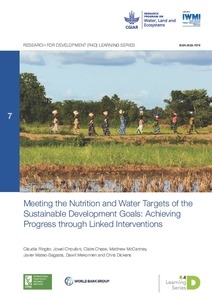The WLE 2018 Annual Report > Planetary boundaries

New technology aiding soil restoration across sub-Saharan Africa
Seventeen African countries are now using soil–plant spectral technology developed by the World Agroforestry Centre (ICRAF) and the CGIAR Research Program on Water, Land and Ecosystems (WLE) to restore soils and boost agricultural production, food security and livelihoods.
About 40% of soils in sub-Saharan Africa are low on nutrients. Widespread soil degradation hampers food production and leads to erosion and desertification. Globally, restoring just 12% of degraded agricultural land could increase smallholder incomes by USD 35-40 billion. However, African governments and other decision makers have long had little knowledge of where to implement what kind of restoration measures.
That’s why ICRAF, WLE and other partners, through the Africa Soil Information Service (AfSIS), have developed and shared technology that can quickly and cheaply measure and map soil and plant properties as well as match soil problems with appropriate solutions. This facilitates better targeting of soil management measures.
The Soil-Plant Spectral Diagnostics Laboratory has helped 14 government institutions, three private sector labs and one development agency to adopt the technology. Data has been used to create soil property maps of Africa at 250 m resolution (SoilGrids). The maps are being used by research and development agencies to guide land management decisions and by the World Soil Information organization to develop fertilizer recommendations for West Africa.
At national levels, AfSIS has helped develop state-of-the-art soil information systems based on spectral technology in Ethiopia (EthioSIS), Ghana (GhaSIS), Nigeria (NiSIS) and Tanzania (TanSIS). Nongovernmental organizations are also using the technology: One Acre Fund, for example, has established a rural spectral lab in Kenya.
Step Aston is the director of agriculture research at One Acre Fund, a direct farmer service organization that provides over 800,000 smallholder farmers with access to credit, agricultural inputs, and training across Africa. "Access to reliable and large-scale, but low-cost soil data is an important part of our ongoing efforts to develop more locally tailored soil fertility management recommendations, and monitoring the long-term impacts that our programs have on soil health," he said.
"To date, our soil lab has processed 50,000 soil samples, deriving insights to inform program strategy and decision-making in six countries. This effort would have been cost-prohibitive were it not for the technological breakthroughs and support delivered by the soil–plant diagnostic laboratory.”
Conservation International, Technoserve and The Nature Conservancy have commissioned spectral analysis services, while the World Bank Living Standards Measurement Study piloted soil spectral technology in Ethiopia and Uganda. In addition, ICRAF has provided advisory services to private companies now deploying spectral technology in 22 countries.
The technology is also helping smallholder farmers benefit from soil- and plant-testing services, through satellite-based data, mobile laboratories and handheld devices. A low-cost, handheld spectrometer was developed and tested, and it has potential to provide a quantum leap in accessibility of the technology for smallholder farmers, helping them solve soil challenges right on their farms.
Over the past four years, ICRAF has trained over 1,000 people from 17 countries on the technologies. More African and Asian countries plan to adopt the technology.
Agricultural challengesare meetingtheir matchWLE 2018-19 Research Highlights
Finding the right solutions puts sustainable agriculture within reach
Sustainable agriculture faces a constellation of ever-shifting challenges. Our world’s population grows toward ten billion, but there is now indisputable evidence of multiple serious social and environmental impacts caused by current agricultural and food systems. We are fast approaching our limits.
Play the Sustainable Agriculture Match GameClick two cards. If the pictures match, the WLE solution will pop up! If not, try again with two more cards
Planetary boundaries
Food systems are a major driver of the unsustainable use of the planet’s increasingly fragile ecosystems. Water, land, forests and the biodiversity are precious, yet finite, natural resources. Current trends show that we are pushing the limits of what Earth can handle. How can we transform agriculture so that it's no longer part of this problem, but part of the solution?
Ann Tutwiler (CGIAR Research Program on Water, Land and Ecosystems (WLE))Board Chair

WLE is establishing a commission to convene global experts on sustainable intensification of agriculture. These experts will bring together years of research by WLE, our CGIAR partners and other science institutions to synthesize the best policies, economic incentives, tools, technologies and practices as well as lay out a roadmap for a sustainable and equitable food future.
Step Aston (One Acre Fund)Director - Agriculture Research

Access to reliable, large-scale, low-cost soil data is an important part of our efforts to develop more locally tailored soil fertility management recommendations and monitor the long-term impacts of our programs on soil health. To date, our soil lab has processed 50,000 soil samples, deriving insights to inform program strategy and decision-making in six countries. This effort would have been cost-prohibitive were it not for the technological breakthroughs and support delivered by the soil-plant diagnostic laboratory.
Food availability
Population growth, demographic shifts, dietary change, climate change and environmental decline challenge everything we know about how to grow and share food. Yet, food production must increase – some estimates say by 50 percent globally, and by almost 100 percent in Africa and Southeast Asia by 2050. But it’s not only about increased production. Better, healthier and more nutritious food is needed too.
Diego Senoner (Indo-German Energy Program)Technical expert

A well-designed KUSUM (Indian solar pump and grid-connected power plant scheme) policy for solar-powered irrigation is important for India to secure sustainable development of agriculture, maintain food security and safeguard groundwater during times of changing climatic conditions.
Marcela Quintero (International Center for Tropical Agriculture (CIAT))Agroecosystems and sustainable landscapes research area director

This data platform for improving water management demonstrates the potential that alliances between research centers and development agencies have to generate products that provide concrete solutions to real problems in agriculture. Likewise, these partnerships allow technical and scientific products to reach end users faster.
Equality of opportunity
In this era of planetary degradation, the world’s poorest and most marginalized often bear the brunt of the burden, losing livelihoods and opportunities. This can drive conflict and migration. With men increasingly leaving rural areas, women are playing a greater role in agriculture, but are still often marginalized and lack access to decision making and resources. At the same time, the sector offers fewer viable jobs to youth. Solutions are only sustainable if they are also equitable.
Abdullaeva Uguloi (Water user association of Obchakoron District, Halivad Jamoat, Tatjikistan)Head of WUA

All water user associations should be headed by women. There is so much work, especially at the beginning, but you have to balance so many tasks, and you cannot give up. Women are more likely to overcome barriers. You have to be happy to always be working. Women are much better at this than men.
Miriam Otoo (International Water Management Institute (IWMI))Research group leader for resource recovery and reuse

The business of safe recovery of water, nutrients and energy from domestic and agro-industrial waste offers significant opportunities to generate economic and social benefits to women and unemployed youth, especially in developing countries. These entrepreneurs, however, face high market entry barriers due to a lack of social networks, specialist skills and capital. It is therefore important to identify appropriate business training for youth or women entrepreneurs, tailored to their specific needs and capacity gaps under each unique geographical context.
2018 Publications highlights
WLE in the news
Thrive Blog Highlights
WLE is grateful for the support of CGIAR Trust Fund Contributors, including direct support from






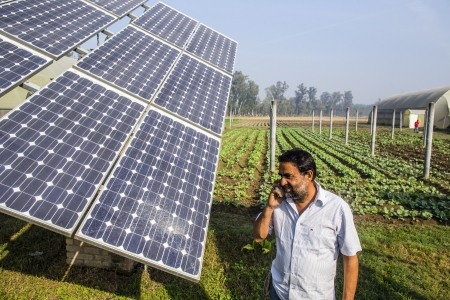


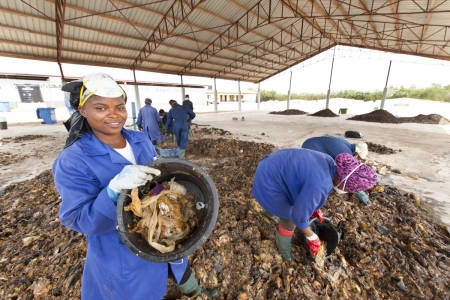
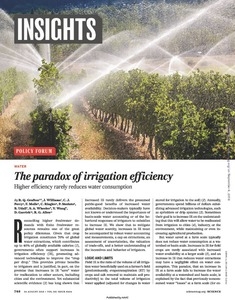

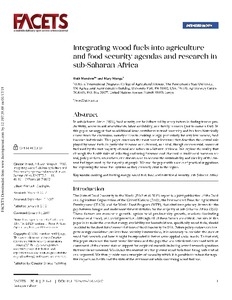

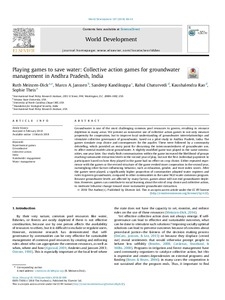

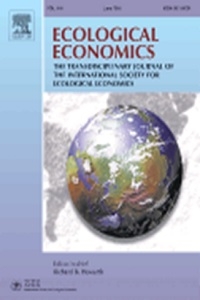
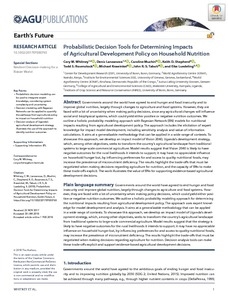
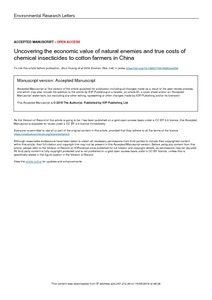
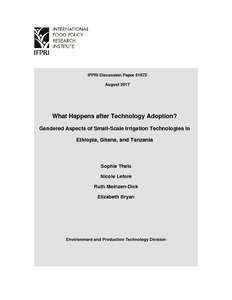




.pdf_/index.jpg?itok=1PqCyZYF)

